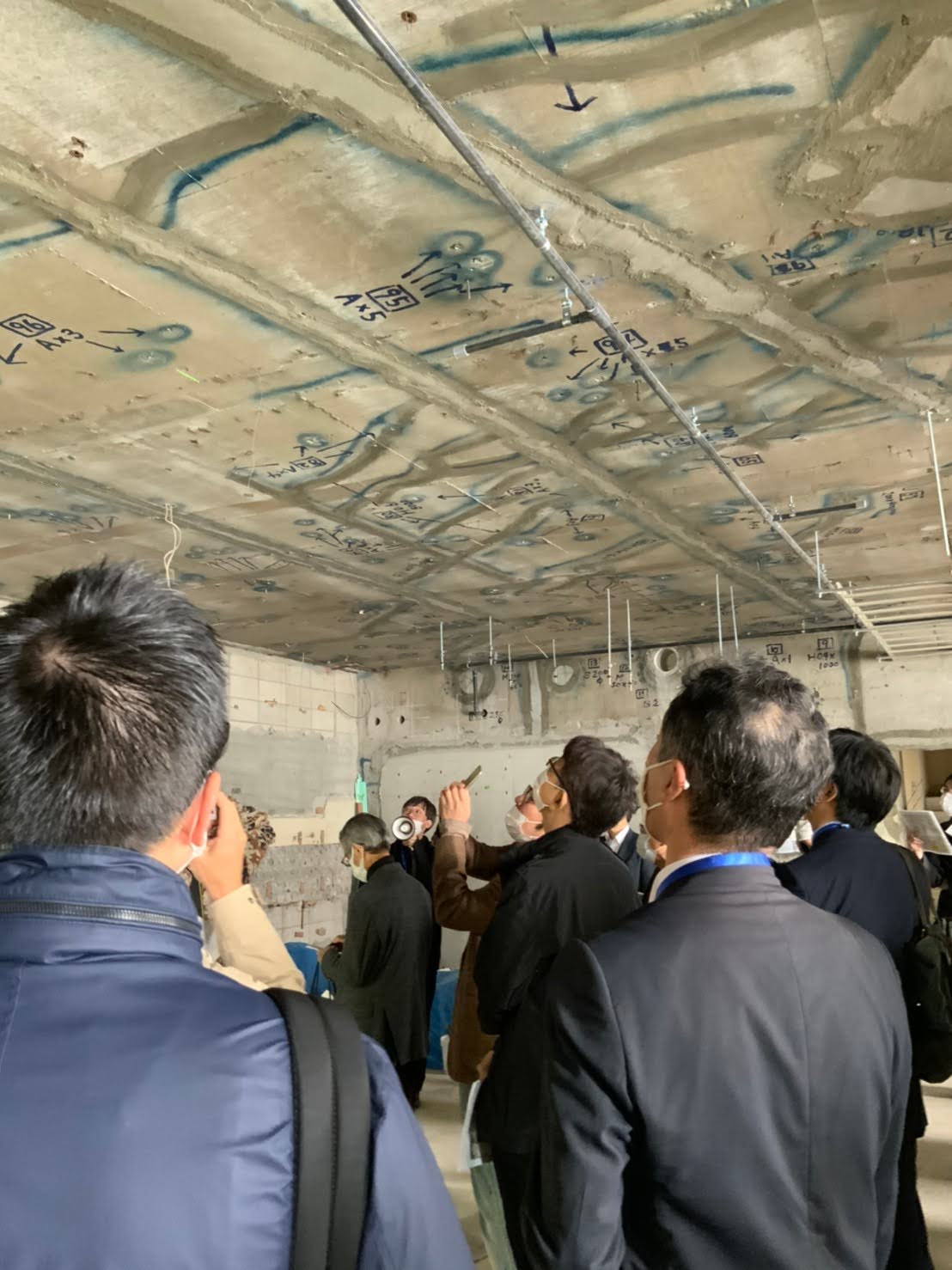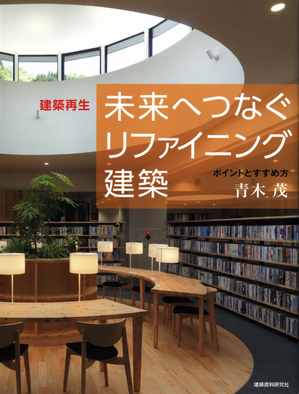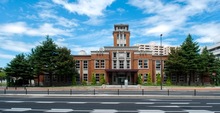- 分類| 再生建築・改修・耐震
- 物件名|Titles:
- 北九州市立戸畑図書館
Kitakyushu City Tobata Public Library
- 竣工年月日|Years:2014年2月
- 設計工期|Years:2011年9月〜2013年12月
- 延べ床面積|Scale:2,889.66㎡
- 用途| Category:教育|Education
- 構造規模|Scale:
RC造 地下1階 地上3階 塔屋3層
- 所在地|Place:北九州市戸畑区新池一丁目1番1号
- 受賞:
第16回公共建築賞(2018)
第8回建築九州賞作品賞(2015)
第56回BCS賞(2015)
JIA優秀建築100選(2015)
第7回北九州市都市景観賞(2015)
第25回BELCA賞ロングライフ部門(2015)
グッドデザイン賞(2014)
第27回福岡県美しいまちづくり建築賞優秀賞(2014)
平成26年度日本建築防災協会耐震改修優秀建築賞(2014)
本建物は1933年に戸畑市役所庁舎として建設された。1963年の5市合併により北九州市が発足した後は、その初代本庁舎として、小倉北区城内に北九州市新庁舎が完成するまでの9年間にわたり利用された。その後は、戸畑区役所庁舎として長く区民や市民に愛され利用されていたが、2007年に戸畑区役所新庁舎が完成して機能を移転したことで、残された庁舎は空き家状態となっていた。
前述のとおり、既存建物は1933年に完成しており、つまり建築基準法が施行される前の状況であった。そのため、コンクリートの品質や鉄筋の配筋の状況など、既存躯体の状況の把握が計画の大前提となった。既存建物の調査を行い、その結果、耐震補強を伴う再生計画となった。
計画を思考するにあたり、いったん図面上で既存建物を原型に戻す作業を行い、内部の増床された部分を撤去し、建設当初のオリジナルな空間の状態を把握するための作業を行った。その上で、調査結果に基づき耐震補強の手法を含む数案の計画検討を行い、そこから1案に絞り込むこととした。その際、旧庁舎のシンボルである塔屋部分や重厚なスクラッチタイル仕上げの外観を保存する為、外部に耐震補強を施さず、内部においてのみ耐震補強を施し、必要な耐震性能を確保することを主眼に置いた。そして数案の中から、構造面、意匠面、そして何よりも機能面を考慮し、図書館としての機能が十分に果たせるか否かという観点から案を絞りこんだ。
補強方法については、構造設計者の金箱温春氏と様々な検討を行った。当初、免震案も検討されたが、建物のスケールに比べ柱が多いことが災いし、コスト的には全く合わないことが分かり廃案となった。採用を決定した手法は、伊東豊雄さんが設計した仙台メディアテークを見た時に浮かんだアイディアであるが、鉄骨による円筒状の補強材を内部に設け、そのことにより地震時の水平応力はこの筒状のものに全て負担させている。既存の外壁は軸力のみと考え検討を進めたが、これでは足りないことが判明し、数カ所に耐震壁を設けることにした。この案で市にプレゼンテーションを行い、計画案が決定された。その後、建物の調査を段階ごとに行った結果、地耐力が想定よりも足りないことが分かり、また振り出しに戻る作業を行いながら、最終的に今回施工された中央廊下の部分に4つ脚の耐震フレームをワンスパンおきに挿入し、水平力を負担させることを考案した。アーチフレーム補強と命名することとした。また既存建物が建設された1930年代は、ヨーロッパの建築様式がアールヌーヴォーからアールデコへと移行し、建築材料として鋳鉄や鉄が多く使われるようになった時代であった。この建物が帝冠様式でつくられた意図は把握できないままであったが、私にとってこの建築が建築様式の歴史的転換にうまれたことの意味は大きく、今回のプロジェクトに思考を深める作業を強いられた。つまり最新の建築様式と建築材料が融合し、このような歴史的な意匠を作り上げたのである。戸畑周辺は、現在の新日鉄住金、かつての八幡製鉄所のお膝元であり、旧戸畑区役所庁舎は企業城下町としての最盛期の建物である。今日という歴史を加えることにより、新たな重層性をつくりたいと考え、補強材として補強にスチールを使用することが最もふさわしいのではないかと考えた。
______________________________________________________
This building was originally built as Tobata city office in 1933. After merger of five cities, it was used as Kita-Kyusyu city's first office for 9 years until the city built a new office in Jonai, Kokura-Kita ward. Although many citizens have loved this building for long time, it became an unoccupied in 2007 because a new Tobata ward office was built and the functions were transferred.
The building was build in 1933 before current regulation established so that firstly we had to survey the situation of concrete and steel.
We planned to reappear building's original shape, therefore, we removed the extensions first. We had surveyed the original body before we planed how to reinforce it for earthquake. To keep symbolic penthouse and massive exterior with scratched tile wall, we placed reinforcements only inside the building not outside. We chose the plan according to the points of structure and design, and also how this building satisfies the functions as a library. Structure designer, Yoshiharu Kanebako and we studied plan of seismically isolated structure, however, it is unsuitable for this building having many columns. The concept of the final structural design is based on an image that I conceived when I saw Sendai Mediatheque designed by Toyo Ito. In short, Sendai Mediatheque has a tube network that structurally supports the building. We thought conducting the same way in this project too, but actually the existing body was weak that is why we chose placing earthquake-resisting walls and finally the city agreed our plan. After we started this project, we faced to its low soil bearing capacity. Therefore, inserting framed reinforcements having four legs between every span are adopted and we called it 'Arched Frame Reinforcements.' In the 1930s when the original building was built, European architecture shifts from Art Nouveau to Art Deco and also construction materials shift from cast iron to iron. Even though I could not reveal why this has an imperial crown style until the last, it was more important to me that the building was built the turing period of architecture. In other words, the latest architecture and the construction materials met and made up such a historical design. Tobata area was a home town of former Yahata ironworks, current Nippon Steel & Sumitomo Metal Corporation, and this former Tobata ward office building is a building of the golden age as the company home town. That is why we chose the 'steel' as a material of reinforcements to accumulate 'today' on the history of Tobata area.















